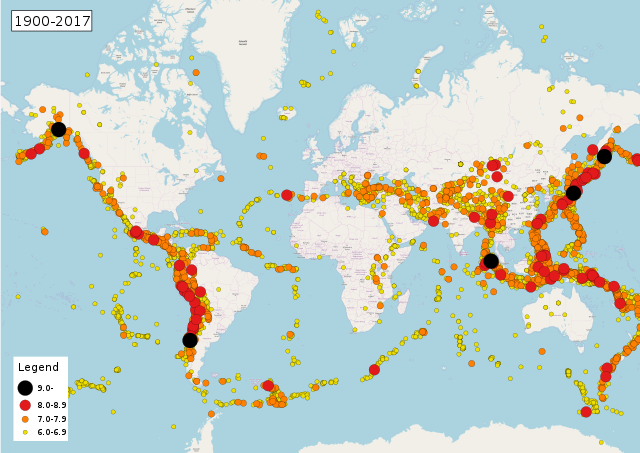The Pacific Ring of Fire is an arc around the Pacific Ocean where many volcanoes and earthquakes are formed.[1] The area is also called the Pacific Rim, a term which refers to the coastal areas of the countries round the Pacific.[2]



About three quarters of the world's dormant volcanos and active volcanos are here. The ring is 40,000km long, and there are 452 volcanoes.[3]
About 90%[4] of the world's earthquakes and 81%[5] of the world's largest earthquakes occur along the Ring of Fire. The next most seismic region (5–6% of earthquakes and 17%[5] of the world's largest earthquakes) is the Alpide belt, which extends from Java to Sumatra through the Himalayas, the Mediterranean, and out into the Atlantic. The Mid-Atlantic Ridge is the third most prominent earthquake belt.[6][7]
The Ring of Fire is a direct result of plate tectonics and the movement and collisions of crustal plates.[8]
Volcanoes
- Avachinsky-Koryaksky in Russia[9]
- Barren Island in the Andaman and Nicobar Islands of India
- Bogoslof island in Alaska
- Chimborazo in Ecuador
- Cotopaxi in Ecuador
- Galeras in Colombia[9]
- Glacier Peak in the US (Washington)
- Irazu in Costa Rica[10]
- Kelut in Indonesia[11]
- Kilauea in the US (Hawaii)
- Krakatoa in Indonesia[11]
- Lō'ihi Seamount in the US (Hawai'i)[12]
- Mount Adams in US (Washington)
- Mount Baker in the US (Washington)[13]
- Mount Fuji in Japan[14]
- Mount Hood in the US (Oregon)[15]
- Mount Lassen in the US (California)[11]
- Mount Mayon in Albay in the Philippines
- Mount Merapi in Indonesia[16]
- Mount Olympus in US (Washington)
- Mount Pinatubo in the Philippines[11]
- Mount Rainier (Tahoma) in the US (Washington)[17]
- Mount Slamet in Central Java, Indonesia
- Mount St Helens in US Washington
- Mauna Kea in US (Hawaii)[18]
- Mauna Hualalai in US (Hawaii)
- Mauna Loa in the US (Hawaii)[18]
- Nevado del Ruiz in Colombia[11]
- Pacaya in Guatemala
- Parícutin in Mexico
- Popocatepetl in Mexico
- Redoubt in US (Alaska)
- Sakurajima in Japan[19]
- Sinabung in Indonesia[9]
- Taal in the Philippines[20]
- Tambora in Indonesia[11]
- Ulawun in Papua New Guinea[9]
- Mount Unzen in Japan[11]
References
Wikiwand in your browser!
Seamless Wikipedia browsing. On steroids.
Every time you click a link to Wikipedia, Wiktionary or Wikiquote in your browser's search results, it will show the modern Wikiwand interface.
Wikiwand extension is a five stars, simple, with minimum permission required to keep your browsing private, safe and transparent.
